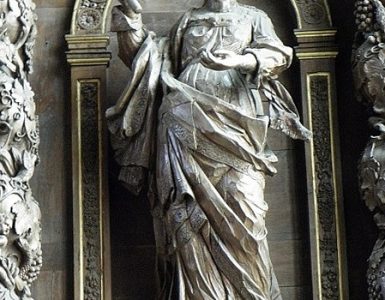The liturgy follows Christ’s life step by step. During the Christmas season, we learn of the birth in the stable, the adoration of the shepherds, the slaughter of the innocents, the flight into Egypt, the adoration of the Magi, and finally the return from Egypt. Then we meet Our Lord again at His baptism, we accompany Him into the desert on his fast, and we go with Him for the first and second years of His public life; we listen to His parables, we admire His miracles, and we unite our hearts with Him in His life of toil and missionary love for us.
Now weeks of instruction have passed. We have followed Our Lord in His apostolic ministry and have reached the moment when, together with Holy Mother Church, we shall contemplate the sorrowful happenings of the last week of His life on earth.
We can feel the hatred of Christ’s enemies growing day by day. On Good Friday we shall witness once more the most frightening of all happenings, foretold by the prophets and even by Our Lord Himself, the bloody drama of Calvary.
The purpose of Passiontide is to call to our memory the persecutions of which Our Lord was the object during His public life and especially toward the end. If Septuagesima season acts as a remote preparation for Easter, and Lent the proximate one, the two weeks of Passiontide are the immediate preparation.
Palm Sunday
Then comes the week that is called in the missal “Hebdomada Major”—our “Holy Week”—in which we accompany Our Lord day by day through the last week of His life, as it is told in the Gospels. First, we join Him in His triumphant entry into Jerusalem on Palm Sunday.

As soon as the Church had been freed by the emperor Constantine in the fourth century, the Christians began to celebrate Palm Sunday in a very dramatic way in Jerusalem. On the very spot where it had happened, the holy texts were read: “Rejoice, daughter of Sion, behold Thy King will come to thee.” The crowd spread their garments on the ground, crying aloud, “Blessed be the King Who cometh in the Name of the Lord.” The bishop, mounted on an ass, would ride up to the church on the Mount of Olives, surrounded by a multitude carrying palms and singing hymns and joyful anthems.
From Jerusalem this reenactment of Christ’s solemn entry into His holy city came to Rome, where the Church soon adopted the same practice. The ceremony, however, was preceded by the solemn reading of the passage from Holy Scripture relating the flight from Egypt, thus reminding Christ’s people that Christ, the new Moses, in giving them the real manna, is delivering them out of the Egypt of sin and nourishing them in the Eucharist.
Around the ninth century, the Church added a new rite. The palms that the people would hold in their hands when they accompanied their bishop were solemnly blessed. We have already witnessed several of these especially solemn blessings, on Epiphany, on Candlemas, and on Ash Wednesday. Again, these texts are so rich in beautiful thoughts for meditation that families should read them together—not only read them, but read them prayerfully.
From Rome the idea to reenact Our Lord’s triumphal entry into Jerusalem spread all over the Christian world. In medieval times, the faithful and the clergy met at a chapel or a wayside shrine outside of town, where the palms were blessed, and from there moved in a solemn procession to the cathedral. Our Lord was represented either by the bishop riding on an ass; or, in some places, by the Blessed Sacrament carried by the king; or, in other places, by a crucifix carried ahead. In some Austrian villages, the figure of Christ sitting on an ass, carved in wood, is carried.
The Christian people had an unerring instinct for the efficacy of those solemnly blessed sacramentals, and just as they carried home Epiphany water and holy candles, they also would bring home with them blessed palms. In the old country this was quite an elaborate function of “the liturgy in the home.” As we did not have real palms growing in Austria, we used evergreens and pussy willows, which at that time were the first children of spring.
Like all other Austrian families living in the country, we made as many little bouquets as there were divisions on our grounds—one for the vegetable garden, one for the orchard, one for the flower garden, one for each pasture, and one for each field. Each of these little bouquets was fastened to a stick about three feet high. Besides, there were many single twigs of pussy willow that would be placed behind pictures all around the house.
These bouquets were gaily adorned with colored ribbons or dyed shavings from the carpenter shop. The children carried them into the church, and each vied with the others, during the blessing, to hold his stick highest to get most of the holy water sprinkled on it. The bouquets were carried in a liturgical procession and afterward were brought home. In the afternoon, the whole family would follow the father throughout the house and all over the grounds, and he would place in the middle of every lot one of those sticks carrying the blessed bouquets as a means of protecting his property against the influence of evil spirits, against the damage of hailstorms and floods.
While the family would proceed from lot to lot, they would say the Rosary. We would alternate between decades of the Rosary and the chants of the day, “Pueri Hebraeorum” and “Gloria, laus et honor.” On Easter Sunday, the family would revisit these sticks, bringing along little bottles filled with Easter water (holy water blessed solemnly on Easter morning). These little bottles would be tied to sticks, thus adding another sacramental.
First Days of Holy Week
According to an old tradition, the first three days of Holy Week—Monday, Tuesday, and Wednesday—are dedicated to spring cleaning. In the days before the invention of the vacuum cleaner, this was a spectacular undertaking: sofas, easy chairs, and all mattresses would be carried out of the house and beaten mercilessly with a Teppichpracker (carpet beater). Walls were dusted, curtains were changed—a thorough domestic upheaval. There is little time for cooking, and meals are made of leftovers.
By Wednesday night, the house looks spic and span. And now the great Feierabend begins. Feierabend is an untranslatable word. It really means vigil—evening before a feast, the evening before Sunday, when work ceases earlier than on any other weekday to allow time to get into the mood to celebrate. Feier means “to celebrate”; Abend means “evening.” From now on until the Tuesday after Easter, no unnecessary work will be done on our place. These days are set aside for Our Lord.
On Wednesday, with all the satisfaction of having set our house at peace, and after the dishes of a simple early supper are finished, we go down to the village church in Stowe for the first Tenebrae service. In the sanctuary, a large wrought-iron triangular candlestick is put up, with fifteen dark candles. We take our places in the choir, and the solemn chanting of Matins and Lauds begins.
This is the first part of the Divine Office, which has been recited daily around the world by all priests and many religious since the early times of the Church. In the cathedrals and in many monasteries, it is chanted in common. For the last days of Holy Week, it is performed in public, so to speak—not only in cathedral churches, but in any church, so that the faithful may take part in it.
We always consider this the greatest honor for us, the singing family, the greatest reward for all the trouble that goes along with life in public, that we can sing for all the Divine Offices in church.
The congregation is following closely with booklets in which the whole service, which we sing in Latin, is given in English. This is the most moving evening service of the whole year. When we sing “Ten-ebrae factae sunt,” an awesome silence falls upon the whole church, and when we sing the famous “Im-properia: Popule meus” by Palestrina, we all are moved to the depths.
Is there anything more heartrending than to listen to the outcry of the anxious Redeemer: “My people, what have I done to thee, or in what have I grieved thee, answer me. What more ought I to do for thee that I have not done?”
✠
This article is adapted from a chapter in Around the World with the Von Trapp Family. It is available from Sophia Institute Press.












